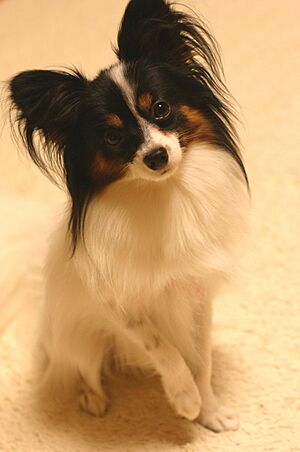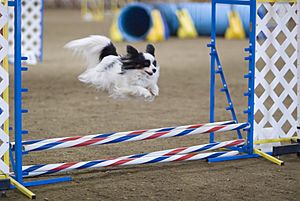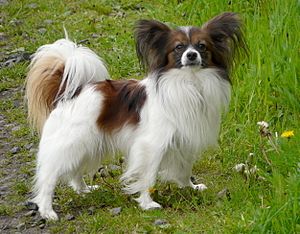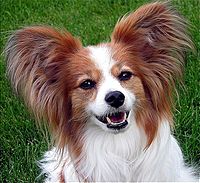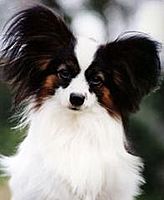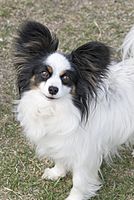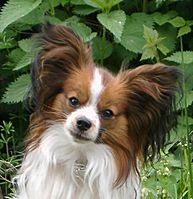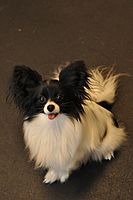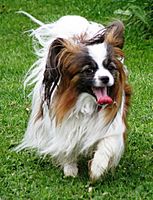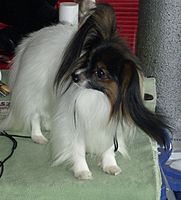Papillon dog facts for kids
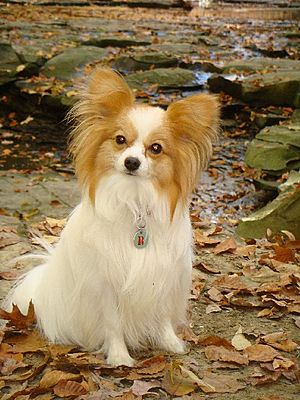
A lemon and white Papillon
|
|||||||||||||||||||||||||||||
| Other names |
|
||||||||||||||||||||||||||||
|---|---|---|---|---|---|---|---|---|---|---|---|---|---|---|---|---|---|---|---|---|---|---|---|---|---|---|---|---|---|
| Common nicknames |
|
||||||||||||||||||||||||||||
| Origin | Belgium / France | ||||||||||||||||||||||||||||
|
|||||||||||||||||||||||||||||
|
|||||||||||||||||||||||||||||
| Domestic dog (Canis lupus familiaris) | |||||||||||||||||||||||||||||
The Papillon is a small, friendly dog breed. Its name comes from the French word for 'butterfly'. This is because of its large, butterfly-shaped ears. The Papillon is also known as the Continental Toy Spaniel. It is one of the oldest types of spaniel dogs.
Some Papillons have floppy ears instead of upright ones. These dogs are called Phalène (pronounced "fah-LEN"). This French word means 'moth'. Both types of ears can appear in the same litter of puppies.
Papillons have a small, rounded head. Their nose area is short and thin. They have dark, round eyes with black rims. Their long tail curls over their back. Their coat is long, fine, and straight. It has extra fluffy hair on the chest, ears, legs, and tail. Papillons are white with patches of any color.
Appearance and Behavior
Papillons are very smart dogs. They are confident and learn new tricks easily. They can be friendly with children and new people. However, they might be a bit shy at first. These dogs can also get along well with other pets. But it's important to be careful with rough pets or cats with sharp claws. They might accidentally hurt a small Papillon.
If Papillons are not socialized enough, they might be wary of other dogs or people. They could even show signs of aggression. Papillons are often playful and loving. They make great companion dogs. They have enough energy for active families. Yet, they can also be calm and enjoy cuddling with their owners.
Because they are energetic, Papillons need a good amount of exercise. They are also excellent watchdogs. They will bark to let their owners know about changes around them. Like many small dogs, they can be quite vocal. Papillons can handle warm weather. But they are sensitive to cold because their fur is a single layer. They should not be left outside in cold temperatures.
The most famous part of a Papillon is its ears. They are large and have long fringes of hair. This makes them look like butterfly wings. Papillons are usually white with patches of color. A dog that is all white or has no white is not allowed in dog shows. A white stripe between the eyes is often preferred. The nose, eye rims, and lips should be black. Their paw pads can be black or pink.
Here are some common colors and markings for Papillons:
| Colors | Markings |
|---|---|
|
|
The American Kennel Club says that the colored patches should cover both ears. They should also extend over both eyes. A little white on the ears or a few white hairs are okay. This is as long as the "butterfly look" is still clear.
There are two ear types in this breed. The common Papillon has upright ears. The Phalène has floppy, spaniel-like ears. The Phalène's ears are likely a trait from their older spaniel ancestors. Both the American Kennel Club and the Fédération Cynologique Internationale (FCI) consider the Phalène and the Papillon to be the same breed.
Temperament
Papillons are generally happy, friendly, and adventurous dogs. They are not shy or aggressive. They can be wonderful family pets. However, it's important to supervise them around very young children. Small children might not understand how to behave around a dog. This could accidentally upset the dog.
Because Papillons are so smart, they need lots of training. They also need mental games and activities. This helps prevent them from getting bored. Boredom can sometimes lead to behavior problems.
Lifespan
Papillons usually live a long time. A survey in 2002 found that Papillons lived for about 11.45 years on average. Some Papillons can live up to 17 years old.
Health
Papillons are generally healthy dogs. However, they can have a few minor health issues. These include patellar luxation (a knee problem) and seizures. They can also have dental problems. Sometimes, they might be at risk for eye problems like progressive retinal atrophy. Back problems (intervertebral disk disease) and allergies can also occur.
Exercise
Playing games is a good way for Papillons to get exercise. But play alone is not always enough. Daily walks or runs are excellent for them. They also love to run freely in a safe, fenced area. Papillons are very active dogs. They enjoy having a "job" to do. Many Papillon owners recommend activities like dog agility, rally obedience, or obedience training. These activities are great for their intelligence and energy.
History
The history of the Papillon can be seen in old paintings. The first small spaniel dogs that looked like Papillons appeared in Italy. The famous artist Titian painted these dogs around the year 1500. Other well-known artists also included them in their paintings. These dogs were popular with royal families across Europe. They were also loved by merchant families. The breed was popular in England, France, and Belgium. These countries are considered the breed's origin by the FCI.
The early spaniels painted by Titian had floppy ears, like today's Phalène. Upright ears did not become popular until the late 1800s. The early "Titian spaniels" were also only red and white. Today's Papillons come in many more colors.
The Papillon's long history with royalty has led to many stories. One story says that Marie Antoinette walked to the guillotine holding her small dog. This story is probably not true. However, it is believed that Marie Antoinette's dog was a small spaniel. This dog was brought to France from Spain. The story says her dog was saved and lived in a building in Paris. This building is still called the Papillon House. Marie Antoinette's dog was said to be from a very old breed called the Epagneul Nain. This breed appeared in church paintings as early as the 1200s.
The Papillon is still officially called the Epagneul Nain (ENC) in many countries. The name "Squirrel Spaniel" was also used. This likely referred to how their tail curled over their back, like a squirrel's tail.
Towards the end of the 1800s, dog lovers started breeding spaniels with upright ears. These dogs were nicknamed papillon because their large, upright ears looked like butterfly wings. The floppy-eared dogs were then called Phalène, meaning "night moth." Both types are still bred today and can be born in the same litter. The Papillon (upright ears) is much more common. However, the Phalène has recently become more popular again.
The Papillon breed was first recognized by the AKC in 1935. This was when the Papillon Club of America was formed. After World War II, the club restarted in 1948.
Papillons have also achieved great success in dog shows. In 1999, a Papillon named Ch. Loteki Supernatural Being (Kirby) won "Best in Show" at the famous Westminster Kennel Club Dog Show. This was a huge achievement for the breed! Kirby also won the World Dog Show in Finland and a show in Canada in 1998. Papillons are also good at other dog sports. These include obedience and agility competitions. In 2019, another Papillon named Planet Waves Forever Young Daydream Believers (Dylan) won "Best in Show" at Crufts, another very famous dog show.
- Papillon portraits
See also
 In Spanish: Papillón para niños
In Spanish: Papillón para niños


